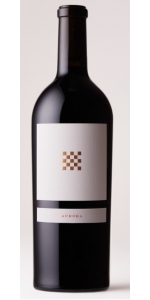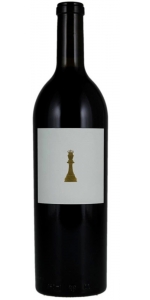Wine from Checkerboard Vineyards
Checkerboard Vineyards is located on the southeast facing slope of Diamond Mountain in Napa Valley. The estate includes a winery, cave and four vineyard sites, joined by a two-and-one-half mile drive spanning the valley floor to the top of the ridge. This dramatic setting is the inspiration for the distinctive, exceptional wines of Checkerboard Vineyards.
The winery is dedicated solely to the vinification of Checkerboard Vineyards wines and was built to control every aspect of winemaking.
Eight custom Taransaud French Oak Upright Casks are used to create numerous, small lots of wine from micro-harvests of each vineyard.
he estate has four vineyard sites of different elevation, exposure and soil composition.
Spring Meadows Vineyard is situated at 600 feet in elevation on a meadow surrounded by Oak, big leaf Maple and Madrone trees. The soils are rich from the neighboring woods and the site enjoys full east to west sun exposure.
Coyote Ridge Vineyard is located on a long undulating ridgeline that runs Eastward downhill from the Aurora Vineyard knoll. The vineyard blocks are perched on the hillside above Nash Creek Canyon to the South and share the same red iron oxide clay as the upper blocks of Aurora Vineyard. Though the soils are similar, the Southern and slightly Eastern exposure of Coyote Ridge, along with its lower 900 foot elevation, allows the top of the summer fog line to reach the Vineyard. This creates an entirely different microclimate and growing cycle for its vines.
Aurora Vineyard is nestled in a small valley midway up Diamond Mountain on a large knoll located at an elevation of 1,200 feet. The knoll projects off the mountainside, giving the vineyard full Southern exposure and open light from the East and West and protection from Napa Valley's summer fog. Six acres of the vineyard are planted in the knoll's rich, volcanic soils that are riddled with basalt cobble in a loamy red clay. The remaining six acres are planted in a deep gravely mix of white volcanic ash and chips of decomposed Rhyolite that were washed down from the steep, rocky crags of Diamond Mountain above.
At 2,000 feet in elevation and at the top of the Estate is Nash Creek Vineyard. The blocks rest just below the East ridge of Diamond Mountain on a steeply sloping terrace composed entirely of Rhyolite. At this elevation, winter temperatures are colder and extend into early Spring, and bud break takes place up to six weeks later than our vineyards below. By early Summer, Nash Creek Vineyard catches up and surpasses the growth of the Aurora and Coyote Ridge Vineyards. This due to the lingering daytime heat absorbed by its rocky base and the nighttime convective warmth rising from the Napa Valley below, providing nearly round-the-clock grape maturation.
Farming practices at Checkerboard Vineyards are based on long-term sustainability and include water conservation and monitoring, permanent cover crops planted in alternating rows, and the use of entomology for pest control.
Vintners Dennis O’Neil and Steph Martin began development of Checkerboard Vineyards in 1999 and retained winemaker Martha McClellan to create a portfolio of wines reflecting the mountainside. The estate includes four vineyard sites of different elevation, exposure and soil composition, providing the foundation for a portfolio that includes Checkerboard Aurora Vineyard, Checkerboard Coyote Ridge Vineyard, Checkerboard Nash Creek Vineyard, Checkerboard Kings Row, Checkerboard Sauvignon Blanc, and Checkerboard Rose. Grapes are harvested at dawn in micro-lots and delivered steps away to the winery where clusters are sorted, discarding any blemished ones. Individual berries are hand-selected for vinification and transferred for fermentation, by hand, to Taransaud wooden tanks, stainless tanks, and individual wooden barrels.
Farming is based on long-term sustainability and includes water conservation and monitoring, permanent cover crops planted in alternating rows, and the use of entomology for pest control and the development of soils with good organic matter and microbiology. Checkerboard Vineyards is a member of Fish Friendly Farming which promotes environmentally-friendly land practices and water quality management. Aurora Vineyard is located in a small valley midway up Diamond Mountain and on a large knoll at an elevation of 1,200 feet. The knoll bulges outward, giving the vineyard full Southern exposure and open light from the East and West and protection from Napa Valley’s summer fog. Six acres are planted in the knoll’s rich, volcanic soils that are riddled with basalt cobble in a loamy red clay. The remaining six acres are planted in a deep gravely mix of volcanic ash and chips of decomposed Rhyolite that were washed down from the steep, rocky crags of Diamond Mountain above.
There's a fresh, sweet aroma to the 2016 Checkerboard Aurora Vineyard that builds excitement and anticipation for what's to come. On approach, the palate is juicy and expansive and explodes with flavors of blackberry, mulberry, dark cherry, caramel, leaf tobacco and green olive. The wine continues with a voluptuousness that's linear and constant yet lifted by natural acidity. The finish is showy, long and lingering with finely polished tannins. An exceptional vintage.
Checkerboard Kings Row Red is made from Cabernet Sauvignon, Merlot, Petit Verdot.
2019 Checkerboard Kings Row is produced from grapes grown in the Aurora Vineyard which is located in a small valley midway up Diamond Mountain on a large knoll at an elevation of 1,200 feet. The knoll projects off the mountainside, giving the vineyard full southern exposure, open light from the east and west, and protection from Napa Valley’s summer fog. Six acres are planted in the knoll’s rich, volcanic soils that are riddled with basalt cobble and loamy clay. The remaining six acres are planted in a deep gravely mix of white volcanic ash and chips of decomposed Rhyolite that were washed down from the steep, rocky crags of Diamond Mountain above. 2019 Checkerboard Kings Row is a complex wine showcasing the Bordeaux varietals grown in the Aurora Vineyard. The nose is a swirl of dark red fruits, baking spice, and sandalwood. On the palate, the fruit dominates and offers hints of dried crushed herbs, black pepper, and freshly pressed espresso. There’s a juicy core which is persistent from the approach through to the finish.
- back
Selected Options
Wineries
Categories
Pricing
Countries
Regions
Grape Types
Wineries
Organic/Free Shipping
Clos Saint-Jean Chateauneuf Du Pape Vieilles Vignes is made from a Grenache, Syrah, Mourvedre, Cinsault, Vaccarèse and Muscardin, the Châteauneuf-du-Pape Vieilles Vignes is made from old vines located in and around Le Crau. The Grenache is aged in concrete for 12 months while the remainder is aged in demi-muid.
Review:
This has good concentration and energy to the dense core of dark fruit and bitter cherry, with great poise and elegance despite its ripeness (an impressive feat for the vintage). Guided by finely crushed mineral accents and tannins, this reveals pretty high-toned floral notes and leafy tobacco. Grenache, Syrah, Mourvedre, Cinsault, Vaccarese and Muscardin. Drink now through 2032. 900 cases made.
-Wine Spectator 95 Points
Boroli Cerequio is made from 100 percent Nebbiolo.
The Boroli family is a family of entrepreneurs, with roots in Piedmont dating back to 1831. The family started their winemaking business in1997, when Silvano and Elena Boroli felt an ardent desire to step away from the pressures of their publishing business and reconnect to nature. Silvano and Elena grew the company until their son, Achille, stepped in to run the wine-growing and production business in 2012.
With the 2012 grape harvest Achille decided to radically change the methods used in vineyards and wineries, aiming for the highest quality in Barolo and its crus. He cut production levels, updated the winemaking technology, and focused on low intervention methods to raise the quality of the Boroli wines be on par with the finest Barolo wines.
About the Vineyard
The Cerequio cru lies just across the valley from the Boroli winery in the commune of La Morra and is considered one of the most prestigious sites in the Barolo DOCG zone. It is known to produce Nebbiolo wine of enormous elegance and finesse.
Wine Production
Cerequio is distinguished by a careful selection of grapes, precise destemming, and a long maceration with submerged cap.
Tasting Notes
A clear bright ruby color with very light garnet red reflections; intense and persistent aroma of red fruit with notes of plum and cherry. A pleasant aroma of wood is noticeable after the fruity aroma, anticipating the full taste of a great wine suitable for long lasting life. A succulent, rich, full-bodied and pleasant taste emerges after the woody one, with the presence of slightly ripe red fruit.
Food Pairing
Thanks to its viscosity and body, Barolo is the ideal wine to pair with elaborate dishes and dishes like truffle dishes, meat dishes, pasta with porcini mushrooms, game, and aged cheeses. Cerequio is also perfect with dry pastries or chocolate.
Review:
Precise and essential, it displays notes of lavender, hibiscus, violet, white pepper, lime, jasmine flowers, and elderberry. Medium body, perfectly ripe, fine-grained tannins, and a juicy finish that displays smoothness and relaxation. Beautiful right away, it will only improve from 2024 onwards. One of the best Barolos tasted in the 2019 vintage.
-WineCritics.com 96 Points






